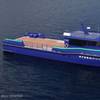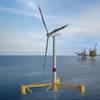USCG Marine Safety Alert
The U.S. Coast Guard issued a marine safety alert while it conducts an ongoing investigation into a engine room fire that killed three aboard the Insignia cruise ship in St. Lucia in December.
The USCG reminded shipowners to maintain machinery, establish escape routes, and conduct thorough engineering watches.
The fire started after a bolted flange parted and a fuel oil spray under pressure developed from an operating engine’s fuel supply line. The fuel spray ignited when it contacted the engine’s exhaust piping or turbocharger components.
The primary fire was extinguished when the vessel’s fine mist extinguishing system automatically activated and performed as designed. Fuel pumps and shutoff valves were also secured.
However, the short-duration fire also ignited cable bundles, quickly filling the machinery space with smoke. As a result, one crewmember and two technicians were unable to egress and perished in the engine room.
Although the USCG emphasized the investigation was not complete, it explained it was issuing the safety alert to:
1) reiterate the importance of vessel engineers being cognizant of and taking action on engine manufacturer technical bulletins and service letters,
2) remind personnel working in machinery spaces to have a personal exit plan no matter where they are working, and
3) stress the value of having engineers frequently perform detailed engineering space inspection rounds on engines, systems, and other equipment.
The ongoing investigation into the fire has revealed that a fuel line supply flange integral to the engine parted after three bolts completely loosened and the remaining bolt fractured. Other bolts within the engine’s hot box were also found broken. The involved engine was a Wartsila model VASA12V32LNE also referenced as a VASA 32. It is a very common engine with thousands operating in ship and shore side service. Over its service life the manufacturer has produced a number of technical bulletins and service letters related to the fuel system piping, shielding of hot surfaces, other fire protection devices, and availability of components to meet SOLAS requirements. In its service letters Wartsila notes that fuel pipes leading to and from the injection pumps are subject to pressure pulses derived from the injection pumps, vibrations caused by normal engine vibrations, and static stresses caused by heat expansion. Any repairs or modifications to the fuel system must follow manufacturer guidance provided in associated manuals, bulletins, and service letters. Owners and operators may obtain engine bulletins and service letters through their Wartsila service representative and other OEM / engine manufacturers.
In this case, the loosening of these bolts may have been caused by vibrational loosening. It is unknown when the involved piping was last removed and reinstalled and whether or not proper torque was applied to the bolts.
Emergency egress was also identified as an issue during the fire investigation. Machinery spaces onboard cruise ships and other large vessels are complex spaces where an unfamiliar person can become quite disoriented, particularly during emergencies. Additional factors like the loss of all Inspections and Compliance Directorate power and lighting or excessive smoke can make rapid evacuation extremely difficult. There are simple steps to improve the odds of a successful escape. Before any work begins, learn the locations of available exits and escape routes in all directions (i.e. up and down levels and platforms, port and starboard).
If there are watertight doors present review the procedures to manually open them if they should be closed. Also learn the location of Emergency Escape Breathing Devices (EEBDs) and review their proper usage and activation. Lastly and very importantly, always carry a good flashlight in your pocket. The light it provides may save your life.
The purpose of engineering personnel conducting rounds in machinery spaces is to identify and initiate intervention, preventative maintenance, and repair actions when unsafe conditions exist. Carefully accomplished, engineers will discover abnormalities as they occur, enabling them to minimize negative compounding events. Identifying discrepancies such as loosening bolts, leaking piping and flanges, excessive oil loss through poor seals and gaskets, failing pump seals, loosening of pipe brackets, inadequate lubricant levels, etc., are typical issues found when thorough inspection rounds are conducted. Each operating engine should be thoroughly examined several times a watch on all sides available noting potential leakages, loosening of components, proper drainage of air coolers, etc. All persons making rounds should be using very bright flashlights in the performance of their inspection duties.
As a result of this casualty, the Coast Guard strongly recommends that owner and operators of all types of vessels develop policy and procedures to ensure:
• They have up to date service bulletins and service letters for critical equipment, implementing the requirements specifically when such items relate to fire prevention and safety;
• That service vendors, technicians, crewmembers, or any persons working within machinery spaces understand their escape routes and available emergency equipment before they start work and;
• That all engineering personnel know how to perform effective and comprehensive inspections and rounds to detect abnormalities and problematic systems, equipment, and components as early as possible.














